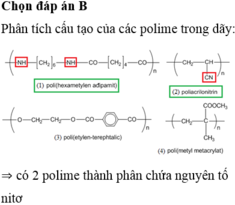Các câu hỏi tương tự
Cho dãy gồm các polime: (1) poli(hexametylen ađipamit), (2) polibutađien, (3) poli(etylen terephtalat), poli(metyl metacrylat). Polime trong thành phần hóa học có chứa nguyên tố nitơ là
A. (4).
B. (2).
C. (3).
D. (1).
Cho dãy gồm các polime: (1) poli(vinyl xianua), (2) poli(hexametylen ađipamit), (3) poli(etylen terephtalat), (4) poli(metyl metacrylat).
Số polime trong dãy bị thuỷ phân trong môi trường bazơ là
A. 1.
B. 4.
C. 2.
D. 3.
Cho dãy gồm các polime: (1) poli(vinyl xianua), (2) poli(hexametylen ađipamit), (3) poli(etylen terephtalat), (4) poli(metyl metacrylat).
Polime không bị thuỷ phân trong môi trường bazơ là
A. (4).
B. (3).
C. (2).
D. (1).
Cho các polime: (1) poliacrilonitrin ; (2) policaproamit ; (3) poli(metyl metacrylat) (4) policloropren ; (5) poli(etylen-terephatalat) ; (6) poli(hexametylen ađipamit) (7) tơ tằm ; (8) tơ axetat ; (9) poli(phenol-fomanđehit) (10) poli(ure-fomanđehit) ; (11) tơ clorin ; (12) polibutađien. Số polime có thể dùng làm tơ hóa học là A. 6 B. 7 C. 8 D. 9
Đọc tiếp
Cho các polime: (1) poliacrilonitrin ; (2) policaproamit ; (3) poli(metyl metacrylat) (4) policloropren ; (5) poli(etylen-terephatalat) ; (6) poli(hexametylen ađipamit) (7) tơ tằm ; (8) tơ axetat ; (9) poli(phenol-fomanđehit) (10) poli(ure-fomanđehit) ; (11) tơ clorin ; (12) polibutađien. Số polime có thể dùng làm tơ hóa học là
A. 6
B. 7
C. 8
D. 9
Cho dãy gồm các polime: (1) poli(metyl metacrylat), (2) poliisopren, (3) poli(etylen terephtalat); (4) poli(hexametilen ađipamit).
Số polime là sản phẩm của phản ứng trùng ngưng là
A. 1.
B. 2.
C. 3.
D. 4.
Cho các polime: (1) policaproamit, (2) poli(hexametylen ađipamit), (3) poliacrilonitrin, (4) poli(etylen terephtalat). Số polime thuộc loại poliamit là
A. 2.
B. 3.
C. 4.
D. 1.
Cho các polime: (1) xenlulozơ triaxetat, (2) poli(hexametylen ađipamit), (3) poliacrilonitrin, (4) poli(etylen terephtalat). Polime thuộc loại poliamit là
A. (2).
B. (3).
C. (4).
D. (1).
Cho dãy các polime sau: (1) poli(metyl metacrylat), (2) poliacrilonitrin, (3) nilon-6,6, (4) poli(etylen terephtalat). Các polime là sản phẩm của phản ứng trùng hợp là
A. (1) và (4).
B. (2) và (3).
C. (1) và (2).
D. (3) và (4).
Cho các polime: (1) poliacrilonitrin, (2) poli(vinyl axetat), (3) poli(metyl metacrylat), (4) poli(etylen terephtalat). Số polime thuộc loại polieste là
A. 1.
B. 2.
C. 3.
D. 4.




